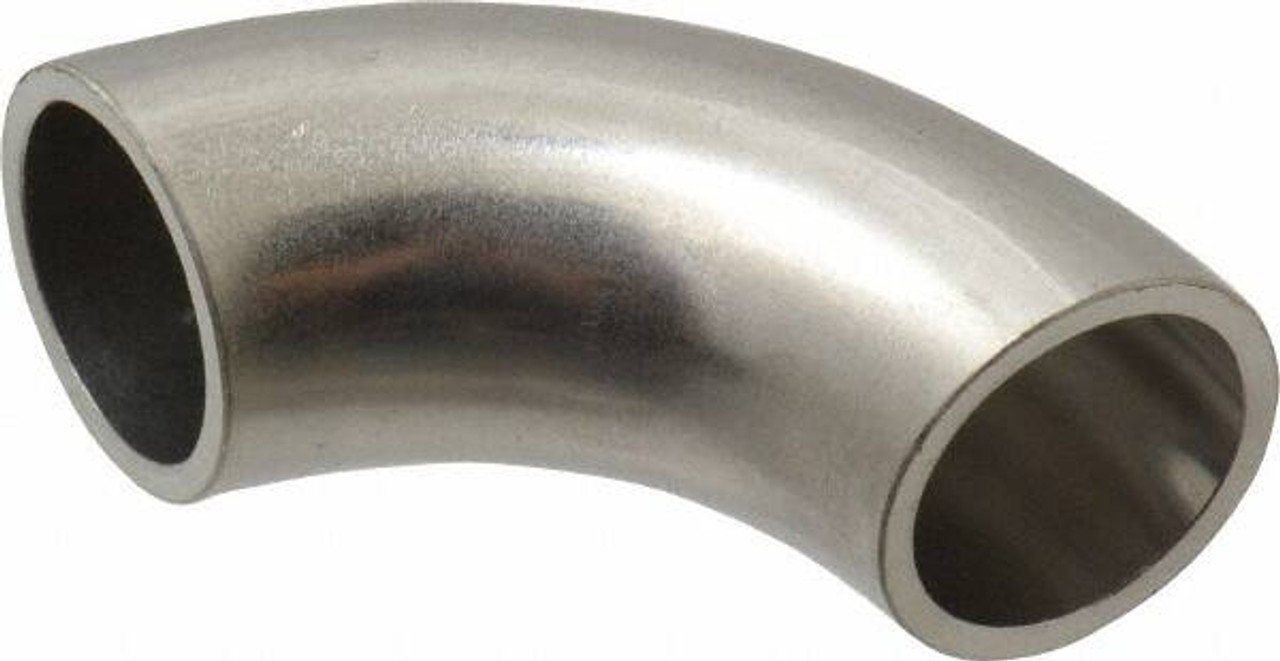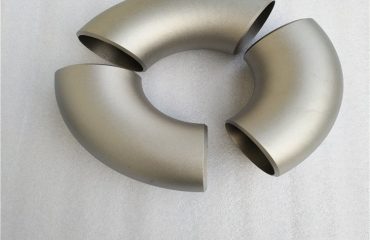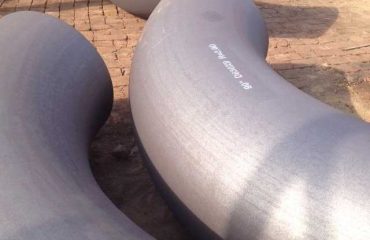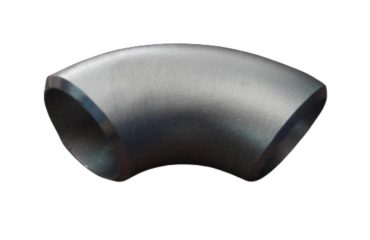
ASME B16.25 الكوع الملحوم بعقب
مقدمة
ASME B16.25 هو معيار يغطي إعداد أطراف اللحام التناكبي لمكونات الأنابيب لعمل وصلة ملحومة. هذا المعيار أمر بالغ الأهمية لضمان التثبيت المناسب واللحام لمكونات الأنابيب, مما يؤدي إلى مفاصل موثوقة وخالية من التسرب. تعتبر أكواع اللحام التناكبي نوعًا شائعًا من التركيبات المغطاة بموجب هذا المعيار, يستخدم لتغيير اتجاه التدفق في نظام الأنابيب بمقدار 45 درجة, 90°, أو زوايا أخرى.
أنواع أكواع اللحام التناكبي
1. 45-درجة الكوع
الكوع بزاوية 45 درجة يغير اتجاه التدفق بمقدار 45 درجة. يتم استخدامه بشكل شائع في الأنظمة التي تتطلب تغييرًا سلسًا في الاتجاه دون التسبب في اضطراب.
2. 90-درجة الكوع
الكوع 90 درجة يغير اتجاه التدفق بمقدار 90 درجة. وهو النوع الأكثر استخدامًا من الكوع في أنظمة الأنابيب, مثالية لعمل المنعطفات الحادة.
3. 180-درجة الكوع
يتم استخدام الكوع بزاوية 180 درجة لتغيير اتجاه التدفق بمقدار 180 درجة, عكس اتجاه التدفق بشكل فعال. هذا النوع أقل شيوعًا ولكنه يستخدم في مواقف محددة حيث يلزم الدوران على شكل حرف U في الأنابيب.
المواصفات والأبعاد
1. الاسمي حجم الأنابيب (مصادر القدرة النووية)
يغطي ASME B16.25 مجموعة واسعة من أحجام الأنابيب الاسمية (مصادر القدرة النووية), عادة من 1/2 بوصة ل 48 بوصة. يرتبط حجم الكوع بحجم الأنبوب الذي سيتم لحامه به.
2. سمك الجدار
يتم تحديد سمك الجدار لأكواع اللحام التناكبي حسب رقم الجدول (مثل, SCH 10, SCH 40, SCH 80). يشير رقم الجدول إلى سمك جدار الأنبوب و, بالتالي, جدار الكوع.
3. نصف قطر الانحناء
هناك نوعان رئيسيان من انحناء المرفق:
- نصف قطر قصير (ريال): نصف قطر الانحناء يساوي حجم الأنبوب الاسمي (1د).
- نصف قطر طويل (إل آر): نصف قطر الانحناء هو 1.5 أضعاف حجم الأنبوب الاسمي (1.5د). يتم استخدام الأكواع ذات نصف القطر الطويل بشكل شائع لأنها تسبب انخفاضًا أقل في الضغط واضطرابًا في التدفق.
4. التحضير النهائي
يتم إعداد نهايات أكواع اللحام التناكبي وفقًا لـ ASME B16.25 لضمان اللحام المناسب. يتضمن هذا الإعداد عادةً شطف أطراف الكوع لتسهيل عملية اللحام.
اختيار المواد
يتم تصنيع أكواع اللحام التناكبي من مواد مختلفة لتناسب التطبيقات والبيئات المختلفة. وتشمل المواد المشتركة:
- الكربون الصلب: مناسبة لتطبيقات الأغراض العامة.
- الفولاذ المقاوم للصدأ: يوفر مقاومة ممتازة للتآكل ويستخدم في المواد الكيميائية, الصيدلانية, والصناعات الغذائية.
- خليط معدني: تستخدم في بيئات الضغط العالي ودرجات الحرارة العالية.
- دوبلكس ستانلس ستيل: يجمع بين خصائص الفولاذ المقاوم للصدأ الأوستنيتي والحديدي, تقدم قوة عالية ومقاومة ممتازة للتشقق الناتج عن التآكل الإجهادي.
عملية التصنيع
1. تزوير
غالبًا ما يتم تصنيع أكواع اللحام التناكبي باستخدام عملية الحدادة, والتي تنطوي على تشكيل المعدن باستخدام قوى الضغط. تعمل هذه العملية على تحسين الخواص الميكانيكية وبنية الحبوب للمادة.
2. تشكيل
في عملية التشكيل, يتم ثني المعدن أو تشكيله في تكوين الكوع المطلوب. يمكن القيام بذلك باستخدام طرق مثل التشكيل الساخن أو التشكيل البارد, اعتمادا على المواد والمواصفات.
3. المعالجة الحرارية
بعد التشكيل, قد يخضع المرفقان لعمليات معالجة حرارية مثل التلدين أو التطبيع لتخفيف الضغوط الداخلية وتعزيز الخواص الميكانيكية.
4. بالقطع
يتم تشكيل نهايات الأكواع لضمان استيفائها للأبعاد والتفاوتات المطلوبة المحددة بواسطة ASME B16.25.
5. التفتيش والاختبار
تدابير مراقبة الجودة مثل فحص الأبعاد, اختبار غير مدمر (NDT), ويتم إجراء اختبارات الضغط للتأكد من مطابقة الأكواع للمعايير والمواصفات المطلوبة.
تطبيقات
يتم استخدام أكواع اللحام التناكبي في العديد من الصناعات, بما فيها:
- النفط والغاز: لنقل النفط الخام, غاز طبيعي, والمنتجات المكررة.
- المعالجة الكيميائية: في الأنظمة التي تتعامل مع المواد الكيميائية المسببة للتآكل والسوائل ذات درجة الحرارة العالية.
- توليد الطاقة: في خطوط البخار ذات الضغط العالي ودرجة الحرارة العالية.
- معالجة المياه: لنقل المياه ومياه الصرف الصحي في محطات المعالجة.
- الأدوية: في أنظمة الأنابيب الصحية التي تتطلب مقاومة عالية للتآكل والنظافة.
التركيب واللحام
1. تحضير
التحضير المناسب ضروري لنجاح اللحام. يتضمن ذلك تنظيف الأنابيب وأطراف الكوع, محاذاة المكونات, والتأكد من التجهيز الصحيح.
2. تقنيات اللحام
تتضمن تقنيات اللحام الشائعة لأكواع اللحام التناكبي ما يلي::
- التنغستن غاز خامل (تيغ) لحام: توفر دقة وجودة عالية, مناسبة للتطبيقات ذات الجدران الرقيقة والحرجة.
- غاز خامل معدني (أنا) لحام: يوفر سرعات لحام أسرع ومناسب للأجزاء الأكثر سمكًا.
- لحام القوس المعدني المحمي (SMAW): متعددة الاستخدامات وتستخدم على نطاق واسع, وخاصة في التطبيقات الميدانية.
3. فحص ما بعد اللحام
بعد اللحام, يتم فحص المفاصل باستخدام طرق مثل الاختبار الشعاعي (ر.ت) أو اختبار بالموجات فوق الصوتية (يوتا) للتأكد من سلامة اللحام والكشف عن أي عيوب.
الاتجاهات والابتكارات المستقبلية
إن مشهد التصنيع والتطبيق لأكواع اللحام التناكبي ASME B16.25 مهيأ لتطورات كبيرة. هذه الاتجاهات والابتكارات مدفوعة بالحاجة إلى تحسين الأداء, الاستدامة, والتكامل مع تقنيات التصنيع الحديثة.
مواد متقدمة
1. سبائك عالية الأداء
يؤدي التقدم في علم المعادن إلى تطوير سبائك عالية الأداء توفر قوة فائقة, المقاومة للتآكل, والمتانة.
- السبائك الفائقة: ويجري تطوير السبائك الفائقة القائمة على النيكل لتطبيقات درجات الحرارة العالية والضغط العالي, مثل تلك الموجودة في الفضاء وتوليد الطاقة.
- سبائك التيتانيوم: معروفة بنسبة القوة إلى الوزن العالية ومقاومتها للتآكل, أصبحت سبائك التيتانيوم أكثر انتشارًا في التطبيقات الحرجة.
2. المواد المركبة
بدأ استخدام المواد المركبة في أنظمة الأنابيب في الظهور, دمج المعادن مع مواد أخرى مثل السيراميك أو البوليمرات لتعزيز خصائص مثل المقاومة الحرارية وتقليل الوزن.
التصنيع المضاف (3د الطباعة)
التصنيع المضاف تُحدث ثورة في إنتاج مكونات الأنابيب المعقدة, بما في ذلك المرفقين اللحام بعقب.
- تصاميم مخصصة: 3تتيح الطباعة ثلاثية الأبعاد إنشاء العرف, هندسة معقدة يصعب أو يستحيل تحقيقها باستخدام طرق التصنيع التقليدية.
- النماذج الأولية السريعة: يمكن للمهندسين إنشاء نماذج أولية واختبار التصاميم الجديدة بسرعة, تقليل وقت التطوير والتكاليف.
- كفاءة المواد: التصنيع الإضافي يقلل من هدر المواد, تعزيز الاستدامة.
التصنيع والصناعة الذكية 4.0
صناعة 4.0 مبادئ, بما في ذلك إنترنت الأشياء (إنترنت الأشياء), بيانات كبيرة, والذكاء الاصطناعي (الذكاء الاصطناعي), تعمل على تحويل المشهد التصنيعي.
1. الصيانة التنبؤية
- أجهزة الاستشعار والرصد: تساعد المراقبة في الوقت الفعلي للمعدات والعمليات باستخدام أجهزة الاستشعار على التنبؤ بالفشل وجدولة الصيانة قبل حدوث الأعطال.
- تحليلات البيانات: يمكن لتحليلات البيانات الضخمة تحسين عمليات الإنتاج, تقليل وقت التوقف عن العمل وتحسين الكفاءة.
2. الأتمتة والروبوتات
- اللحام الآلي: تضمن أنظمة اللحام الأوتوماتيكية الجودة والدقة المتسقة, تقليل الأخطاء البشرية وزيادة الإنتاجية.
- المصانع الذكية: تعمل الأنظمة المتكاملة والروبوتات على تعزيز المرونة والقدرة على التكيف في عمليات التصنيع.
الاستدامة البيئية
أصبحت الاستدامة محورًا رئيسيًا في تصنيع مكونات الأنابيب.
1. إعادة التدوير والاقتصاد الدائري
- إعادة تدوير المواد: التأكيد على إعادة تدوير المعادن لتقليل استهلاك المواد الخام والأثر البيئي.
- الاقتصاد الدائري: تصميم المنتجات لسهولة تفكيكها وإعادة تدويرها في نهاية دورة حياتها.
2. عمليات صديقة للبيئة
- التصنيع الأخضر: تنفيذ العمليات التي تقلل من استهلاك الطاقة والانبعاثات, مثل استخدام مصادر الطاقة المتجددة.
- الطلاءات منخفضة التأثير: تطوير الطلاءات التي تحمي المكونات دون آثار بيئية ضارة.
تقنيات الطلاء المتقدمة
تعمل الابتكارات في تقنيات الطلاء على تحسين أداء وعمر أكواع اللحام التناكبي.
- طلاء النانو: طبقات رقيقة للغاية توفر مقاومة فائقة للتآكل, مقاومة التآكل, وخصائص مسعور.
- طلاءات الشفاء الذاتي: الطلاءات التي يمكنها إصلاح الأضرار الطفيفة تلقائيًا, إطالة عمر خدمة المكونات.
تعزيز التفتيش والاختبار
تحسينات في الاختبارات غير المدمرة (NDT) الأساليب تضمن أعلى جودة وموثوقية.
- اختبار الموجات فوق الصوتية المتقدمة (أوت): تقنيات تصوير عالية الدقة للكشف عن العيوب وضمان سلامة اللحام.
- مراحل صفيف الموجات فوق الصوتية (وصلة): يوفر صور مفصلة من اللحامات, مما يسمح بالتوصيف الدقيق للعيوب.
التوائم الرقمية
مفهوم التوائم الرقمية- النسخ المتماثلة الافتراضية للمكونات المادية - تسمح بمحاكاة وتحليل الأداء في ظل ظروف مختلفة.
- التحليل التنبؤي: محاكاة سلوك المكونات في ظل سيناريوهات مختلفة للتنبؤ بالمشكلات المحتملة وتحسين التصاميم.
- تحسين الصيانة: استخدام التوائم الرقمية لتخطيط أنشطة الصيانة وتحسين إدارة الأصول.
استنتاج
تلعب أكواع اللحام التناكبي ASME B16.25 دورًا حاسمًا في موثوقية وكفاءة أنظمة الأنابيب عبر مختلف الصناعات. فهم المواصفات, مواد, عمليات التصنيع, وتعد تقنيات التثبيت ضرورية لاختيار هذه المكونات واستخدامها بفعالية. من خلال الالتزام بالمعايير وأفضل الممارسات الموضحة في ASME B16.25, يمكن للمهندسين والفنيين ضمان السلامة, أداء, وطول عمر أنظمة الأنابيب الخاصة بهم. من المقرر أن يتشكل مستقبل أكواع اللحام التناكبي ASME B16.25 من خلال التقدم في المواد, تقنيات التصنيع, وممارسات الاستدامة. من خلال تبني هذه الاتجاهات والابتكارات, يمكن لهذه الصناعة تعزيز الأداء, مصداقية, والبصمة البيئية لأنظمة الأنابيب, تلبية المتطلبات المتطورة للتطبيقات الحديثة.
يقدم هذا الدليل الشامل نظرة عامة تفصيلية على أكواع اللحام التناكبي ASME B16.25, يغطي كل شيء بدءًا من الأنواع والمواصفات وحتى عمليات التصنيع والتطبيقات. يوفر هذا الدليل نظرة ثاقبة للاتجاهات والابتكارات المستقبلية في تصنيع وتطبيق أكواع اللحام التناكبي ASME B16.25, تسليط الضوء على كيفية وضع التقنيات والممارسات الناشئة لتحويل الصناعة.




يجب ان تكون تسجيل الدخول لإضافة تعليق.